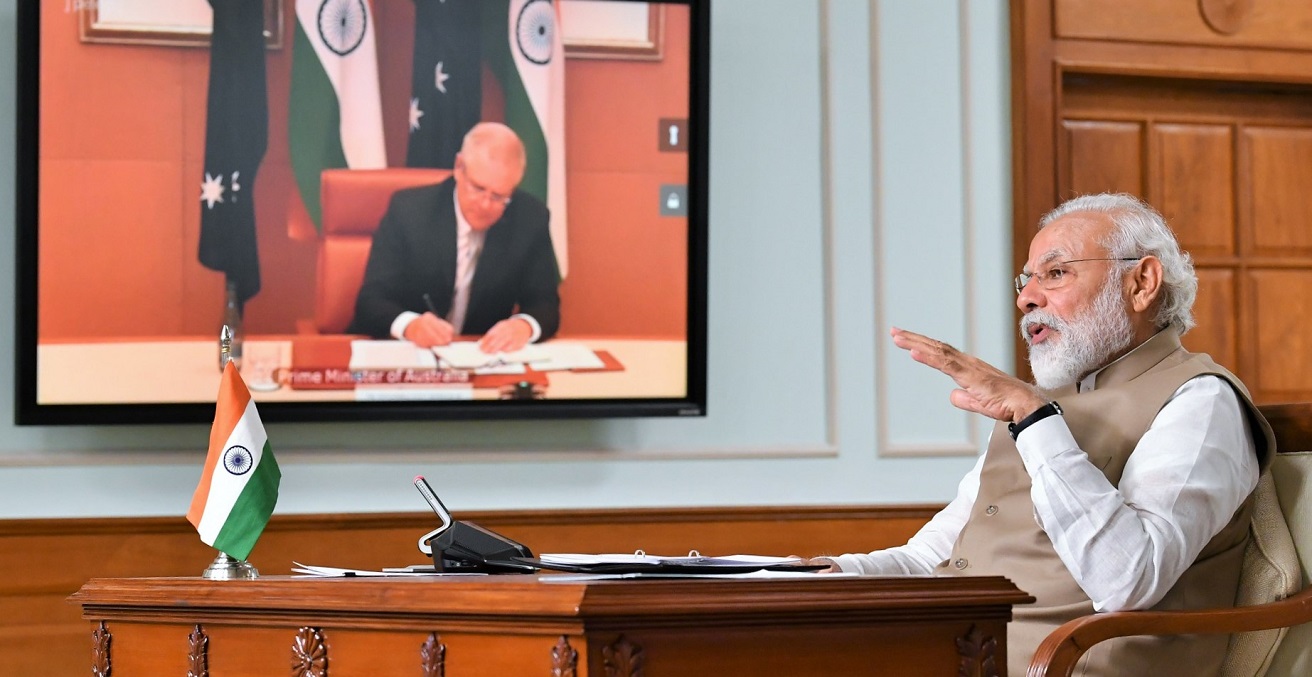India-Australia Virtual Summit: What Did We Achieve?

India and Australia’s relationship has evolved over the years. Once estranged nations now look to one another as key strategic and diplomatic partners in the Indian Ocean region and in the Indo-Pacific region at large.
The first ever India-Australia virtual summit held on June 4, 2020 was conducted in a rather unusual context. The COVID-19 pandemic has pushed all diplomatic and political interactions online, and the geopolitical clashes between the United States and China have started to cause ripple effects across various diplomatic and strategic relationships the two nations hold with emerging and middle powers such as India and Australia.
Prior to the summit, experts and analysts anticipated some much-needed developments in the bilateral relationship between both the nations. The most important was the need for India and Australia to sign a Mutual Logistics Support Agreement (MLSA) for greater defence and strategic interoperability. The two nations were also expected to discuss enhancing their association with one another within the Indo-Pacific region. Naval exercises like AUSINDEX and MALABAR have been key turning points in their strategic relationship. While talks of including Australia as a permanent member of MALABAR have been doing the rounds since 2019, the most recent edition of AUSINDEX in 2019 was upheld as a huge success. The inclusion of four frontline ships with integral helicopters, one submarine, and a variety of aircraft, including the P8I and P8A long-range maritime reconnaissance antisubmarine warfare aircraft, symbolised intentions of deeper defence cooperation between two states.
In Quad meetings in 2018 and 2019, analysts remarked on how the forum could increase prospects of economic, political, and diplomatic convergence between both nations. Over the years, India and Australia have expanded their cooperation in a variety of areas, including security, defence, nuclear disarmament, terrorism, global peace, and the environment. In 2009, the two nations upgraded their strategic partnership in a Joint Declaration on Security Cooperation. In 2014, India and Australia signed a Framework for Security Cooperation which officially started the process of increasing trade in uranium for peaceful purposes. However, there were also fears of stagnation in their relationship when no significant progress was seen in their strategic relationship. There were contentions that the role of China in Australia, as well as Indian strategic and policy considerations, may have played a role in the two nations taking measured steps with one another.
In this most recent summit, however, most of these contentions were challenged. Key issues that bother both the nations were brought to the table. The opportunities and prospects of the Indo-Pacific region were actively discussed. There was also a commitment to increase in defence and strategic cooperation through the much-anticipated MLSA. Apart from this, the two nations made key developments in agriculture cooperation, water resource management, education, culture, tourism, and enhancing people-to-people connections. The summit also saw Australia’s vociferous support for India’s candidatures to become a member of the Nuclear Suppliers Group and for a non-permanent seat of the UN Security Council.
In his opening remarks at the summit, Indian Prime Minister Narendra Modi expressed his committed desire to expand relations with Australia in a comprehensive and quick manner. The pace at which the two states have enhanced their relationship since the end of this summit has hit ambitiously feverish levels.
One of the most important developments since the end of the summit has been the release of the Joint Statement on a Comprehensive Strategic Partnership (CSP) between the Republic of India and Australia. A key aspect of most of the agreements and collaborations agreed upon between the two states is that they largely use the current COVID-19 pandemic and the subsequent global crisis it has unleashed as an initiator. Therefore, even when one looks at the agreement on a greater CSP between the two states, it cannot be ignored that there is a deep commitment on both the sides to address the COVID-19 challenge effectively. Another factor for consideration regarding the CSP is how their evaluation of the nature of the Indo-Pacific region has been subtly merged with the understanding of the two nations on the COVID-19. In the statement, the two states note the “importance of a globally coordinated response to COVID-19 and working to build a prosperous, open, stable post COVID-19 world.” This is similar to their vision on an “open, free, rules-based Indo-Pacific region…that promotes prosperous, stable and sovereign states on the basis of shared interests.”
Under this CSP, the two nations have ensured that the COVID-19 crisis becomes the backbone to greater science, technology, and research collaboration. India and Australia have started a new phase of the Australia-India Strategic Research Fund (AISRF). The AISRF supports scientists in India and Australia working together and supports research collaboration in a variety of fields such as agriculture, astronomy and astrophysics, biomedical devices and implants, and clean energy technologies. The joint statement promises to promote innovative solutions for the COVID-19 response. They have also agreed to increase prospects in areas of the digital economy, cybersecurity, and critical and emerging technologies and build greater cyber-resilience through the framework arrangement on cyber-enabled critical technology cooperation.
The main highlight of their meeting, however, was the Joint Declaration on a Shared Vision for Maritime Cooperation in the Indo-Pacific. The statement reiterated the enduring interest of both countries in a “free, open, inclusive and rules-based Indo-Pacific region.” By expressing concerns regarding non-traditional trade practices which are “inconsistent with international law,” such as terrorism, piracy, drugs, and arms smuggling, the two nations reflected their shared interest in ensuring freedom of navigation and open sea lines of communication within the region.
A related aspect to this is the evaluation the two nations presented on the role of regional and multilateral arrangements. “ASEAN centrality” continues to be the mainstay of the two nations’ economic and political endeavours within the region. The Indian Ocean Naval Symposium (IONS) and the Indian Ocean Rim Association (IORA) continue to be viewed as institutions which can guarantee growth for the two states in the region. The two countries also expressed their desire to develop the Indo-Pacific Oceans Initiative (IPOI), which shall look at areas of cooperation in preserving marine ecology.
The two sides also committed to work together through various “plurilateral mechanisms” such as trilateral meetings with Japan, Indonesia, New Zealand, The Republic of Korea, Vietnam, and the United States. The inaugural Quad ministerial meeting of September 2019 was welcomed by the two states.
It is notable that the two nations avoided any discussions regarding China. India and Australia in recent times have been in tense situations with China. Keeping China out of the picture might be an effort to not aggravate, if not de-escalate, their respective tensions with China.
The acknowledgement of IONS and IORA as organisations better suited for the Indo-Pacific region and not the Indian Ocean region is also to be noted. While analysts expected the two nations to sign a Comprehensive Economic Cooperation Agreement (CECA), the deliberations for which started in 2011, they did agree to re-engage on the bilateral CECA. The aim is to find a mutually agreed way which addresses the remarkable progress in the trading relationship between India and Australia.
The India-Australia Virtual Summit has marked a key turning point in India-Australia relations. The changing geopolitical circumstances have increasingly pushed the two countries to take a more individualistic and non-dependent posture on the role and relevance of dynamic regions like the Indo-Pacific in their strategic thinking. The growing association between the two nations in areas of defence and science and technology promises to bolster their relationship. In times when major powers such as the United States and China threaten send tectonic tremors across the existing world order, it is in the hands of emerging and middle powers such as India and Australia to ensure that they are prepared to handle any geopolitical shocks that may arise from great power competition. This summit was a step forward in that direction.
Kanchi Mathur is a postgraduate student at the Department of Geopolitics and International Relations at the Manipal Academy of Higher Education in Manipal, Karnataka, India.
This article is published under a Creative Commons Licence and may be republished with attribution.





